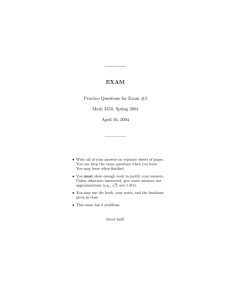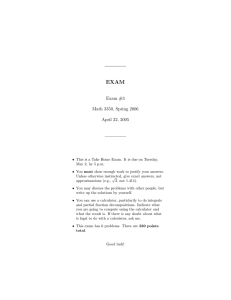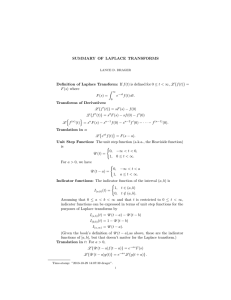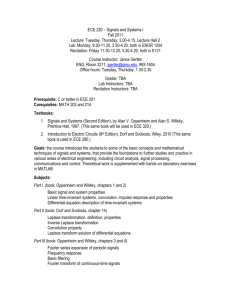Document 10440326
advertisement
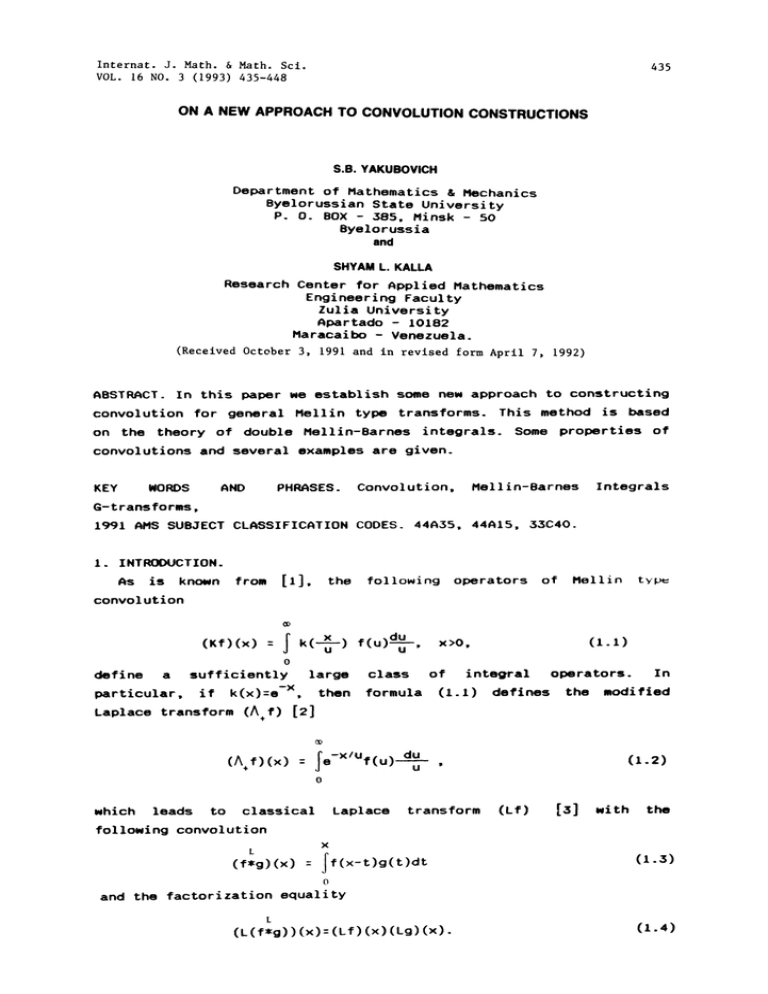
Internat. J. Math. & Math. Sci.
VOL. 16 NO. 3 (1993) 435-448
435
ON A NEW APPROACH TO CONVOLUTION CONSTRUCTIONS
S.B. YAKUBOVICH
Department of Mathematics & Mechanics
Byelorussian State University
P. O. BOX
385, Hinsk
50
Byelorussia
and
SHYAM L. KALLA
Research Center for Applied Mathematics
Engineering Faculty
Zulia University
partado- 10182
Maracaibo- Venezuela.
(Recelved October 3, 1991 and in revlsed form Aprll 7, 1992)
ABSTRACT. In this paper we establish some new approach to constructing
convolution for general Mellin type transforms. This method is based
on the theory of double Hellin-Barnes integrals. Some properties of
convolutions and several examples are given.
KEY
PHRASES.
AND
NORDS
Mellin-Barnes
Convolution,
Integrals
G-transforms,
1991AHS SUB3ECT CLASSIFICATION CODES. 44A35, 44A15, 33C40.
1. INTRODUCTION.
As
is
[1],
from
known
the
following
operators
of
typ
Mellin
convo I ut i on
x
k(---)
(Kf)(x)
f( u) du
u
(1.1)
x>O
o
define
a
sufficiently
particular,
if
k(x)=e
Laplace transform
large
-x,
then
class
formula
of
integral
(1.1)
defines
operators.
the
In
modified
(/+f) [2]
(A+f)(x)
e-x/Uf(u) dUu
(1.2)
0
which
leads
to
Laplace
classical
transform
(Lf)
[3]
with
the
following convolution
x
(f=g)(x)
f(x-t)g(t)dt
(1.3)
0
and the factorization equality
L
(L(f*g)) (x)=(Lf) (x) (Lo) (x).
(z.4)
S.B. YAKUBOVICH AND S.L. KALLA
436
Recently we
[4]
have developed a method of generalization of
Laplace convolution (1.3) on Mellin
transforms (1.1).
LYI:>
and
general
Bore
5 ].
G-transforms
In
case
this
the
be
in
with G-function
effectively extended to the integral transforms
kernel
It can
the
factorization equality of type (1.4) takes the following form
(1.5)
(K1 (f’g)) (x)= (Kzf) (x) (K3g) (x),
here (fg)(x) is general convolution which is defined below for three
(K1,K2,K3).
operators
Zn case of classical Laplace transform it is the
(G1,G2,G 3)
set (L,L,L), for G-transforms it is
(see below).
In this paper we consider some properties of these convolutions
in special spaces and their various integral representations. By this
method one can obtain the known convolutions and many new examples.
2. SOHE FUNCTIONAL SPACES, G-TRANSFORH AND ITS PARTICULAR CASES
In this section we will consider generalization of the Mellin type
[2]
convolution transform (1.1) by Hellin-Parseval equality
"+ ic
where
*
k * (s)
1
(Kf)(x)
2=i
f* (s)x
’ds,
(2.1)
denotes the Nellin transform of functions k(x),f(x)
f(x)x-ldx,
f (s)
(2.2)
0
(-i,/i) is some vertical contour in the complex plane s. Thus the
transform (1.1) can be studied with aid of asymiptotic of function
k=(s) and f=(s) on the contour o (-i, /i=), in particular, hen
{s, Re(s)=7=l/2}.Our
o=
main aim is to consider transforms of the form
(2.2) which are convenient for our further studies.
Thus the behaviour of the functions
k=(s)
and
f=(s)
on the contour
o can be observed from the fact that their inverse Hellin transforms
-I(L) [5].
belong to the space of functions
As is shown below this
space is very convenient for the studies of transform (2.2).
DEFINITION
(0, +),
Denote
1.
representable
functions
f*(s)
by
E
L(O)=L(o)
space
--1
multiplication
-1
(L)
(L)
by
i th
scalar
space
the
Helln
of
functions
transform
f(x),
x
integrable
of
on the contour o:
f*(s);
f(x)
The
(L)
inverse
by
the
is
x
2i
usual
linear
addi tion
of
operations
vector space.
If
the
and
norm
in
is introduced by the formula
HfI-I(L)
[If*(l/2+it)ldt,
(2.4)
-I(L) is a Banach space.
Now we consider main properties of the space
then the space
1) f(x) e
This
-(L)
property
if and only if x
follows
from
the
-1
f(x
fact
-1
e
that
"
’1(L).
(L).
the
functions
f(x)
and
NEW APPROACH TO CONVOLUTION
CONSTRUCTIONS
437
(s)*and
f(x- )
are the inverse Hellin transforms of the functions f
*
f (l-s) respectively, But the functions
(s) and f * (1-s) either both
belong to L(o) or none of them belong to L(o).
x
f*
2) If f(x) e -l(L) then x
(x) is bounded uniformly, continuous on
1/2
(0, +=) and furthermore x
f(x)= 0(1) when x-> and x--> O.
This property follows from the Riemann
Lebesgue lemma
Z-(L) then x 1/2 f(x)g(x) -(L).
3;) If f(x), g(x)
1/2
This fact follows from that x
f(x)g(x) is the inverse Mellin
1
g* (s-z/l/2)dz which belongs to
transform of the function
f*
(t)
2i
J
L(o) by Fubi-ni theorem. Here g(x)=
I-I(L)
4) Let f(x) e
-1
(s); x
and x -1/2g (x) e L(B+).Then
g(u)
x
f(G)
d__u
belongs to
u
0
-
(L)
In fact by the property of the Mellin convolution this integral is
inverse
the
f=(s)E
Mellin
g(s)
L(o) and
hence f
transform of
(s)g*(s)
f*(s)g*(s)
the. function
and
since
belongs to space of essential bounded functions,
L(o).
[1]
As is known by
the Mellin transform of G-function is the ratio
of products of gamma-functions and according to asymptotic expansion
of gamma-functions this ratio has power-exponential behavior on the
contour o. Therefore it is necessary to take into consideration this
fact in the spaces of, -(L) type.
DEFINITION 2.[5]. Let c,7
I be such that
+ sgn ()_>0.
2sgn (c)
Deno te
,(L)
by
the
space
of
2.5
representable by the inverse Mellin transform
xe
E
f(x),
functions
x
(2.3), where
e
(o, +,),
(s)lsl
Note that
f=(s)lsleol’’"lelL()l
f and only f
f=(s)lslZe=l’le
L(), and in this case the integraZ in (2.3) converges if c>O, 7
or c=O, 7>0, ehich is equivalent to (2.5).
The sce
(L) is Banach sce ith norm
-
s oous
eth the
sce
that the
-
ecl’sl isZf *(s) lds
fM-c,7 (L)
Zt
x
)
L
sce
(L).
c,7
(L)
n
case
C:O,
(2.6)
:0
coincides
DEFINITION 3. The G-transform of function f(x), x>O, is defined as
(Gf)(x)= G m’n
()p
P’ql()
where o:{ s e
,
o f(u) (x):
Re(s)
o
1/2 }, O<_m<_p
m
(s)
2i
i(s)
(s)x-ds,
(2.7)
n
P
q
T-T (+s) T r(z-p-s)
r
j=n+l
x>O,
O_<n<_q,
r(z--s)
T r (e +s) T-T
J"
j=m+l
B,
(2.8)
438
S.B. YAKUBOVICH AND S.L. KALLA
Here, e assume that
Re
(/j)+l/2>O,,j
1/2-Re((x ) >0, ,.i=1
m;
1
(2.9)
Re((xl)+l/2>O,,
I/2-Re(.BI)>O,
(c*,*), where
* =re+n-
=
P/q
2
Re
.1
q
j=m+l
p;
n+l
DEFINITION 4. The ordwred pair
C
n;
(2.10)
Gj-
is called the index of the G-transform (2.7)
1.[5].
THEOREN
I"c,(L)
space
case
this
exists on the
if and only if
2sgn (c+c
In
(c*,?*)
The G-transform with the index
the
) +sgn ( +
maps
G-transform
(2.11 )
) >0.
1
(L)
into
isoorphically
X+X
e see that the inversion of G-transform
G-transform and it can be written as follows
No
(2.7)
also
is
-1
,;
/ ()
xil (s)l
g(u) (x)=
()
(o)
q,
q
g* (s)x-eds
(2.12)
o
The following theorem represents our G-transform defined by contour
(2.7) in the traditional real form. The proof is obvious from
integral
type convolution (1.1).
the Hellin
THEOREH 2. Let
+ sgn
2sgn(c
:’I’:)
then the G-transform
(?*
(2.13)
1)>0,
(2.7) ith the index
(c*,*)
can be represented
in the real form (1.1) as follows
(Gf)(x)=
p, q
x
,J’G;
o
"q
(s)x-
2i
(j) qj
((X)p
"n
f(U) du
(2 14)
ds is Heijer’s G-function
[1]
<7
Here the existence of the G-transform (2.7) is guaranteed by
Definition 2 of I-1
c, (L) (see
(2.13) and inequality (2.5) in
(2.11) ).
Theorem
convergence
G-function.
of
2
shows
integral
inequali ty
that
which
is
used
for
(2.13)
provides
definition
of
also
the
Heifer’s
REHRRK 1. If inequality (2.13) is replaced by
4sgnCc*)
2sgn(?*)
+ sgn IP-ql > O,
then the statement in Theorem 2 is also true (see [5]).
Further,since the Pleier’s G-function is rather a general function,
its particular cases
+
lead to a
number of corresponding
transforms.
Here e give a table of those transforms hich are required to study
439
NEW APPROACH TO CONVOLUTION CONSTRUCTIONS
the convolutions. For convenience we introduce the following notations
of transforms (see
k(x)
[2]).
k(-G-)f(u)--G-
f(u)
k*
2i
L
o
x=k (x)
f(u)
k
x
(----) f (u)
du
u
x-f(x)
k(x)
x
o
(xk (x)x-) (f) (x),
f(u)
k(x)
2i
L
xCk(x)
f(u)
k*(s)
2i
L
Now
we
give
G-transforms
(k =(s))
is
a
table
the
in
defined
by
k* (s+)
the
of
forms
(2.16)
definitions
(2.15)-(2.18),
important
of
where
(2.8) such that p+q_<2.
the
These
simple
function
(s)
transforms
are
special Bodifications of known classical integral transforms and their
inversions (Laplace transform, Hankel transform, Stieltes transform,
Riemann-Liouville differintegral operators, Heifer transform).
The more general particular cases of G-transforms, which will be
introduced in section 4, can be easily obtained from (2.15)- (2.18) by
the table of Hellin transforms and representations of the
using
kernels k(x) through Heijer’s G-function
[6].
TABLE 1
SIMPLE ZNTEGRL G-TRNSFORHS AND THEIR INVERSIONS
Hodified Laplace transforms
G ’0
0,1
_
s-uf(u)
A+f(x)=
f(u)
f(u) (x):
0
o
A_f(x)=
f(u)
f(u) (x)=
GZ, o
e
-(/’)
o
f(u)
e-
x-ef(x)
x
u-el(
(2.1
du
(2.21)
0
,1
0
(2.22)
L
Ae-()
(u)
]
2i
)
Hodified Riemann-Liouville differintegral
and their inversions
o,
f(u) (x):
GI’I
0
(_u)_
r()
0
u
r
()
(u)du, Re()>O
f(u)
orators
440
S.B. YAKUBOVICH AND S.L. KALLA
x
; (x-u)/
dx"
d
n-1
u -f (u)du
r(=*n)
-n<Re()<-n+l or Re(x): -n,
o
I(o)#O, n:t,2,3
G1
f(u) (x):
1
J" (u-x) =r(,)
d
u
r(+n)
f(u)
r ()
0
u-Xf (u)du,
(u)du
:z
=_
(x-f(x)):
Re (=) >0
(2.24)
-n<Re(=)<-n+t or Re(=)--
n,
x
Im (=)0, n:1,2,3
r ()
}"I
f(u)
]
z
(x-f(x)):z+/-(x
(x))
(2.25)
(2.26)
Hodified Hankel transforms and their invers-ons
2,0
0
2
z, -u/z
f(u) (x):
3p(2/-)
f(u)
(z. :9)
(2.o)
Sin- and Cos- transforms and their inversions
GO,2
,0
f(u) (x):
:n(2)/’)
f(u)
[’jsin(2__)f(u) du
o
G2, 0
f(u) (x)
in(2x
(2.)
441
NEW APPROACH TO CONVOLUTION CONSTRUCTIONS
’sin(2) f (u)dU
(2.33)
o
112
cos
1
(2) f (u)dU
(2.4)
--1
sin(2V--)
f(u) (x):
x
0
)
sin(2x
f(u) (x)=-=---cos(2y/---)
/2
cos(2x
x
)
sin(2--)
x
(x)=
f(u)
I
f(u)
(2.3;6)
f(u)
f(u)
cos(2x-l/2)
cos(2V-)
x
(2.35)
f(u)
in(2x -2)
f(u) (x)
0
f(u)
(2.37)
f(u)
f(u)
(2.30)
Hodified Stieltjes transform and its inversion
s,,, )
f(u)
r()(+x)-
(x)
r(O)
0
,1
,1
;
1 P
f(u)
1
2{i
(x)
"
uPf(u)
(x+u)O
r(p)(l+x)
du
(2.3;9)
u
-P-t
r(s)P(o-s) f* (s)x
Sds
(2.40)
L
Plodified Pleijer transforBs and their inversions
2,0
GO,2
f(u)]
S.B. YAKUBOVICH AND S.L. KALLA
442
2Kt)(2/ X/U "f(u)dUu
(2.41)
o
0,2
G2
-/z,Z./z
f(u) (x)=
0
2
2K
f(u)
=2K=,(2 u /x
0
2Ku(2V’-
f(u) (x)
/2,-/2
,2
1
1
F(s+/2)F(s-p/2)
2i
)f (u) duu
(2.42)
f(u)
(s)x-Sds
(2.43;)
L
Z-p/z, Z+u/z
0 2
0
f(u) (x)
G
1
2/[i
2K
2
f(u)
1
f* (s)x-’ds
]" r(s+/2)r(-s-u/2)
(2.44)
L
DEFINITION AND RAIN PROPERTIES OF CONVOLUTIONS FOR MELLIN
TYPE TRRNSFORS
No e consider the Laplace convolution (l.3)if f(x), g(x)
I-(L). By Definition 1 substituting representations (2.3) for f(x),
g(x)
(1.3), changing order of integration and using the
in
beta-integral we can represent (1.3) in its equivalent form3;.
(f=L
x
g)(x)
(2i)
where o x o
={(s
t)
E
z
(s)
F(2-s-t)
(t)x
-tdsdt,
(3.1)
o o
z
Re(s)=
Re(t):1/2}
For Laplace convolution (3.1) e have the folling result.
THEOREM 3. The classical Laplace convolution (f=g(x) (1.3) exists for
-(L) and it sseses the fatorization prorty
all f(x), g(x)
(1.4). Zn Lh case x
-112
L
(f.g)(x)
E
I- (L).
POF. From (3.1) L fotlows LhaL the Laplace convoZuLon
exists f and only f
r(z-s)r (z-t)
f* (s) g* (t)
r(2-s-t)
E
L(osx Or).
(fg)(x)
(3.2)
Using the representation for the beta-function we obtain that
r(z-s)ro-t)
r (2-s-t)
o(I)
hen s t-->(R)
(s t) e o xo t"
(3 3)
f*(s) g*(t)E
Bt
by Definition 1 it follows that
L(osxot).Hnce
the condition (3.2) holds valid. Further by the substitution =s+t-I/2
representation (3.1) can be written in the following form:
x/Z
(f=Lg)(X)
re
0={:
x
[
e
,
-
r(3;/2-)
1
Re()=Z/2}.
d
I
2i r(1/2-+t)r(l-t) f* (-t+1/2) g* (t)dt,
(3;.4)
443
NEW APPROACH TO CONVOLUTION CONSTRUCTIONS
(.g)(x)
Hence it follows that x
(L). Now by an appeal to the
classical Laplace transform
e-XUf(u)du
(Lf)(x)
0
(3.1) it is not difficult to obtain the property
and the convolution
(1.4) Theorem 3 is proved.
The representation (3.t) for Laplace convolution can be modified
and generalized on the G-transform (2.7).
DEFZNITION 5. Integral convolution (f*g)(x) for two functions f(x) and
g(x) for .the set of three G-transforms (G1,G2,G3)is defined as the
following integral.
Hl(S+t)Hz(SH3(t)
)
1
(f*g)(x)
)’2ni’2
g* (t)x--tdsdt,x>O,
f * (s)
(3.5)
where H (s), j
1,2,3 are the corresponding kernels of G-transforms
(G f)(x)which are defined by the following relations:
m.
(
Hj (s):r
-(.J
+s,
"j
(
)+s
PJ
n,r(+s)n,r(-.-)
))-s
-(
qj
k=n
r(,s)
+1
(.6)
r(+1
Thus by Definition 5 e see that for each convolution defined by (3.5)
there corresnds the ordered set (G,G,Ga)of G-transforms and vice
Hence
versa.
e
obtain
corresnding G-transforms.
s
G-transform
fami Zy
the
As
of
is known
also G-Eransform.
integral
froa
[5],
convol utons
for
the coBsi[o
Hence e can noEe some algebraic and
sCructural prorties of these convolutions (see 1o).
HEOREH 4.
Let f(x), g(x)
H.(s)
2 3 and
=1
-1
(L) and for Nraaeters of the
the corresndng conditions (2.9) hold.
H(s+1/2)
Let further,
[1 t)lexp(-c(lsl+lt I)) Istl-7]<+,
Sup
(s
E
t)
[Hl(S+t)]-H(s)H3(t).Then
here (s,t)
1/2
and x
t
(f=g)(x)
By
PROOF.
(3 7)
(S
o xo
(L).
cond ton
(s,t)f*(s)g=(t)
the convolution (3.5) exists
(3.7)
L(osxot).
and
Def n ton
2
Jt
Hence e rJte the ntegral
fol los
tha
(3.5) Jn the
following form (see 3.4).
-1/2
(f*g)(x)
2wi
--[
H1(+1/2)
H_(l/2+r-t)f* (1/2+;-t) H3(t)g*(t)dt,
2i
(,:3.8)
o
and using Definition I the proof of Theorem 4 is completed.
THEOREH
5.
Let
the
conditions
of
Theorem
4
hold
following inequalities hold
2sgn (c+c)+sgn (+1)> 0
j=2 3
and
moreover
the
444
S.B. YAKUBOVICH AND S.L. KALLA
i=2,3- indices of G-transforms with corresponding
(3.6). Then the factorization equality of type (1.5)for the
G-transforms set (G1,G,G 3) is true
c
where
kernels
(G1 (f-g)) (x): (Gz f) (x) (G3g) (x),
where
def
(Gf)(x)
112
-
_(t1z f)(x)
-lZ
(L),
f(x)
x
H(s)=H(s+I/2).
case
in
kernel
x
G
G-transform
and
the
has
(L) and Hellin-Parseval equality
1/z
(G z f) (x) (G3g) (x) is the
(2.1) we notice that the function h(x)=x
Further the
inverse Hellin transform of the t-integral of (3.8).
PROOF. By the property (3) of
condi Lions
G ,j=2,3.
to
Gl-transform
NOW we apply
the
provide
5
Theorem
of
(3.5)
convolution
-
corresponding factorization equality.
THEOREH 6. Let (s,t)
(X
l/2f(x), X-
112
g(x)
L(osxot)and
--
f(x), g(x)
L(l*)).
E
L(x
G-transforms
of
existence
obtain
and
-112
the
,1+)
Then the following real representation of convolution (3.5) holds-
(f=g)(x)
S
2
S(x,y)
(s,t)x
dudv
f(u)g(v)
y
(.9)
MV
(3. 0)
dsdt.
can I: obtained by Fubini theoreM.
convol utions in
form
(3.9), where the
kernels S (x, y) depend on the sum and maximum o f
The proof of Theorem
Now
consider
corresponding
the
[7]
variables x,y. As it is known from
(s, t)
and
(s+t)k* (s+t)sHI(S)=
Hz(S)=H3(s)=(s)
where
h(x)=x
k
=(s)
-1/2
k (x)
t
-1
(for
(s,t)=
maximum).
transform
[,E],
h*(s)
O<-<E<,.
Ih(x)x -dx,
Hi(s)= s
some
of
[8]
belongs to the space I
arbitrary segment
(for sum)
In
the
1
,H z (s)=H3(s)=s
case
first
=
k (s)
and in the second case
is. Hellin
k=(s+tB(s,t)
=
k (s)
function
k(x)
such
that
of integrable functions on
Further the integral
o,
s
(3.11)
0
converges, i.e.there exists a constant C>O, for which for all
,
E>O
and t E R
E
k(x)x
t-11
REHARK 2. In particular, if k(x)
Zdx
-
< C.
L(O,), then h(x)=x
(3.12)
1/2
k (x)
!.
445
NEW APPROACH TO CONVOLUTION CONSTRUCTIONS
.
(L), x tk (x)
Let f(x),g(x) c
the
following
integral representations of type (3.9) for convolutions(3.5)
(f*g),(x)
THEOREM 7.
and
(f*g)max(X)
Then
are true
l"
(f’g) (x)
I
k
u+v
x
UV
k x max
(f*g)max(x)
R
1
f(u)g(v) dudv
{u
(3.13)
UV
f(u)g(v) dudv
uv
}
,v
2
(3.14)
The proof of Theorem 7 can be obtained by Fubini theorem and using
of the following identities
[7]
B(s, t)k*(s+t)=
k (x+y)x
R
S+t
st
y
Thor
s-1
dxdy,
y
(3.15)
2
k*(s+t)= k(max{x,y}x s- y -dxdy.
it
i
(3.16)
not
(G+(f*g)/)(x)= (A+f)(x)(/+g)(x),
(3.17)
(G,ax(f*g)(x)=(Zlx-l)(f)(x)(!_ _lx’l)(g)(x),
(3. le)
where
G-transform G
and G
have the kernels as indicated above
and operators in right parts of (3.17), (3.18) are defined by Table I.
Now we consider some estimations of norms for convolutions (3.13),
(3.14) in traditional L-spaces.
THEOREM 8.Let k(x)
L(O,-) and f(x),g(x) L(x -112 ;O,-).(x -l/Zg (x
(0,)). Then the convolutions (f*g)/(x),(fg),ax(X)
L(O,) and
following estimations of norms are true
-
L(R
L
the
;R
L(x
(.9)
The proof of Theorem 8 can
obtained
folling chain of inequalities and equalities.
ok
R
<
x max
2
,v- }
Ik(x)Idx min{u
2uv
lk(x) Idx
u-
2m&u,v}
f(u)g(v),
uv
v}lf(u)g(v)I dudv
UV
f(u)g(v) dudv
UV
<2
uv
f (u)g(v)
’k(x)ldx -1
R
R
446
S.B. YAKUBOVICH AND S.L. KALLA
dUdVuv
lf(u)g(v)l,
,/ Uv
Ik(x) ldx
_<
R
eualities
R
k(x)=2Ko(2 /)be
EXAMPLE 1. Let
corresponding
dudv, Ik(x)ldx lf(u)l
u
dv.
R
MacDonald function
(3.13), (3.14)
convolutions
lg(v)
du
and
their
[1].
Then the
factorization
can I ritten in the fors
UV
2
/\
(
(f’g)
(f’g) +) (x)
(x)-- 2
2
2xt/2K (2-)
(^/f) (x) (/\/g) (x),
Ko 2
g)ma
UV
(U)
max{u
x
(3.20)
f(u)g(v) dudv
v
UV
(Ilx 1) (f) (x) (11
-1
4. SOME EXAMPLES OF CONVOLUTIONS AND FACTORIZATION EQUALITIES
section we give a table of examples of integral convolution by
this
In
real representation (3.9) with S(x,y) as hypergeometric function of
two variables (Horn functions)[9]. Some other Horns functions can be
defined by the use of G-function of two variables [4]. The sets of
G-transforms in factorization equalities follow from Table 1 and table
of Mellin transforms in
[1], [6].
TBLE 2
e
W
(g)(x).
1-e’-’ x’-
x
v
(4.2)
f
o o
(x-/_ lx(
( f*g ) (x) :’
()
)
(u)g(v)dUdv
uv
(x){,F, Z’--x)}
(’"
(g)
447
NEW APPROACH TO CONVOLUTION CONSTRUCTIONS
(f*g) (x)=
2
dudv
F, (,,,
(x -(o+)/2.
2
K_( x ,,z
}-
u
x
(o+)/2 )(f*g)(x)= r()r( )
r()r()
-(f)(x) (x
x(x
x{a,_1(2x112)}
(f*g)(x)=
o o
(4.4)
)(g)(x).
x
x
x
U
V
) f (u)g(v)dUdv
MY
[( z+x)-C}(f) (x) A+ (g)(x).
@2 ()’’ "
(x-XA_xX)(f*g)(x)=r()
x
v
u
(z+x)
x
v
(f’g)(x)=r()){(].+x)-/} (f)(x)A/
x
f
-’
(g)(x).
x
v
3
(2x’/z )
}
x
F
(],’-1)/ (g)
(g)(x).
(4.7
) f (u)g (v,)dudv
uv
(x (1-’)/2
(4.8)
(x).
dudv
)f(u)g(v)
uv
(x -(A-_
Ix
(f*g) (x):
r()
(4.6)
(u)g(v)dUdv
My
---)I (/;7"-x)}(f)(x)
(x-A-- Ix) (f’g) (x)-r ()
(4.5)
) f (u)g(v)dUdv
My
(f)(x) (1+x)
x
u
xl ,_
(--7’
r()
r() t
(x1- I o-]’xi’-.)(f=g)(x)
(x-’A_x ’)
uv
v
(x (I-7)/2
S.B. YAKUBOVICH AND S.L. KALLA
448
x
x(3
_
f3_l(2Xl/Z)t X(-I)/Z)(f)(x)(x(1-"
t
-
)/2
x
(2X1/2 ) X(’’--1)/2 ) (g) (X).
’=’1
(f*g)(x)=
(’="P’ ;-
o o
(x-il’A_x ’) (f’g) (x)=[’(
r(,/2+
uv
v
;s )r(*+
)
r()r()
(4.o)
x
No, p_a
2
(
) (f)Cx)
A+Cg)(x).
(4.11)
_
ACKNOLEENEMENT. This work was partially funded by a grant from the
CONDES of th Zulia university.
REFERENCES
1.- HRRICHEV,
0.I. :"
Handbook o__f Integral Transforms o_f Higher
Transcendental Functions", Ellis Hor)od, Chichester, 1983.
Itogi Nauk__
2.- BRYCHKOV, Yu.A.
GLAESKE, H-Yu., HRRICHEV, O.I.
English
Tekhniki: Ha__t. Anal., re1. 2_1, VINITI, 1983, pp. 3-41.
transl, in 3.Soviet Math. 30 (1985), no. 3.
Itogi Nauki i Tekhniki: Mat.
3..- DITKIN, V.A., PRUDNIKOV, A.P.
Anal.,
VINITI, 1967, pp. 7-82.; English transl, in Progress in
Hath.vol. 4, Plenum Press, New York, 1969.
4.-YAKUBOVICH, S.B.: Dokl. A_N BSSR, 34, N 7, 1990, 588-591.(Russian).
5.-VU KIM TURN, MARZCHEV, O.I.; YAKUBOVICH, S.B.: Dokl. A__N_N SSSR 28__6,
1986, 786-790; English transl, in Soviet Math. Dokl. 33 (1986).
6.- PRUDNIKOV, A.P.
BRYCHKOV, Yu.A.
MARICHEV, O.I. :" Integrals and
Series Here Special Functions", Gordon and Breach, New York, 1989.
7.- NGUYEN THANH HRI, YAKUBOVICH, S.B.: Dokl. AN BSSR, 34, N 5, 1990,
396-398. (Russian).
8.-VU KIM TUAN: Dokl. AN SSSR, 28__6, 1986, 521-524; English transl.in
Soviet Math. Dokl. 33 (1986).
Higher
9.- BATEHRN, H., ERDELYI, A.
Transcendental. Functions,
HcGraw--H11 New York, 1953.
